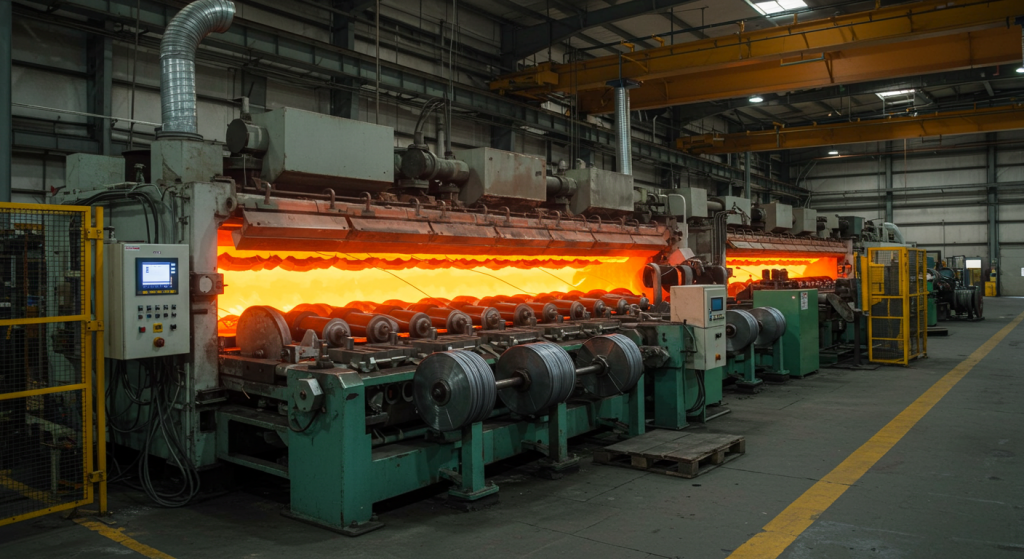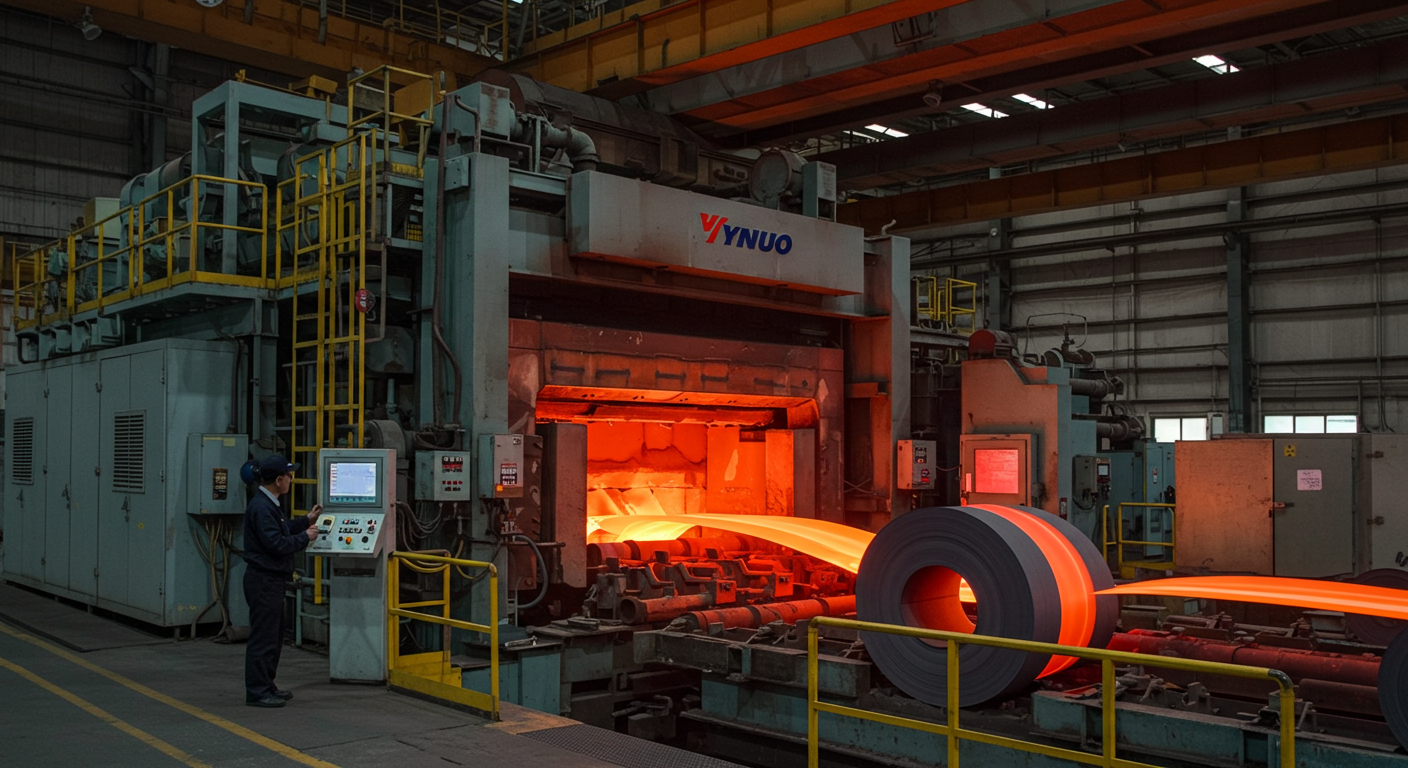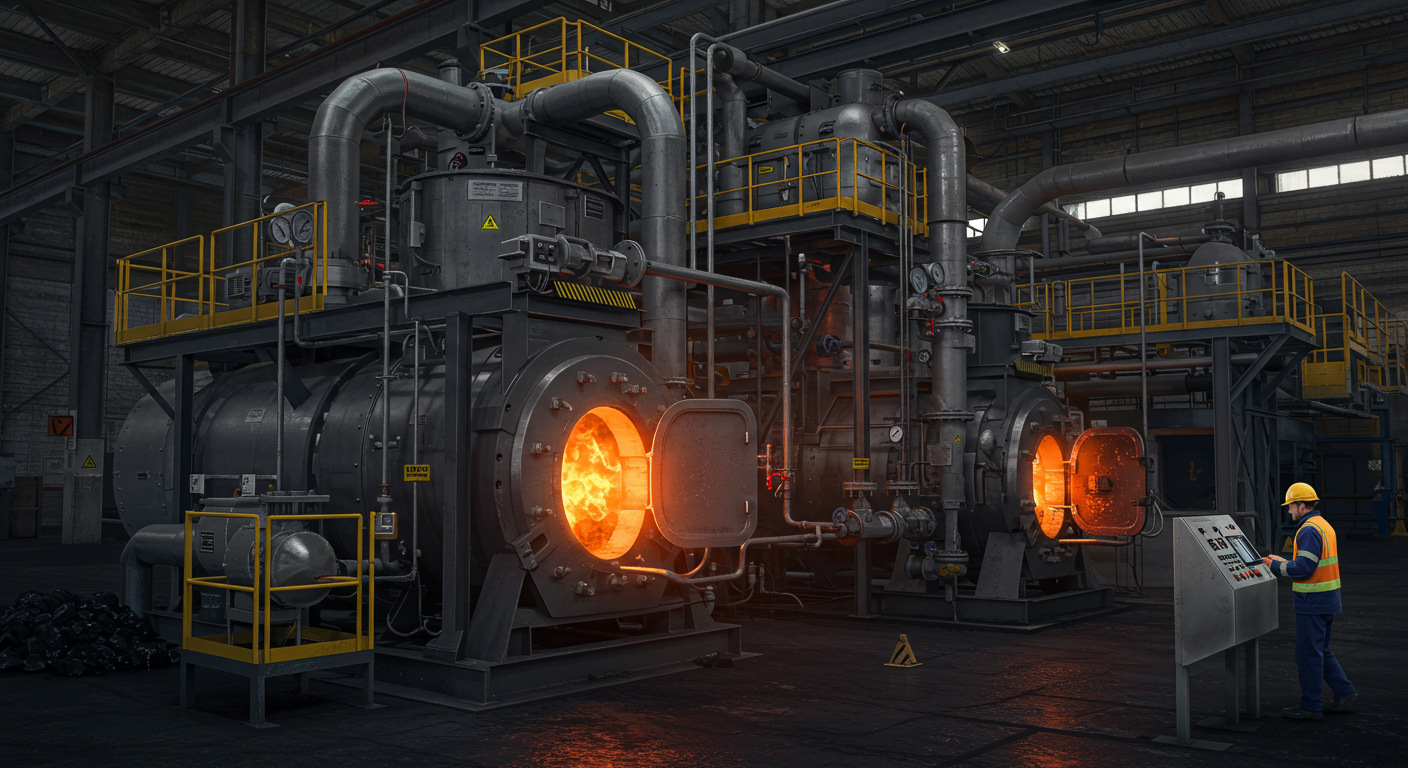
Wire annealing furnaces are specialized systems designed to heat treat metal wires, such as steel, copper, or aluminum, by heating them to specific temperatures and cooling them at controlled rates to enhance ductility, reduce hardness, and improve electrical conductivity. These furnaces are critical in wire manufacturing for industries like electronics, automotive, and construction, where wire quality directly impacts product performance. Jiangsu Yinuo Thermal Energy Technology Co., Ltd., based in Xuzhou, China, stands as a global leader in manufacturing advanced wire annealing furnace solutions. This guide explores the technology, applications, and benefits of wire annealing furnaces, detailing their role in modern industrial wire processing with a focus on precision, efficiency, and versatility.
Understanding Wire Annealing Furnace Technology
Wire annealing furnaces heat metal wires to temperatures typically between 500°C and 1000°C, depending on the material, to relieve internal stresses, refine grain structure, and enhance workability. The design prioritizes uniform heat distribution, controlled cooling, and compatibility with continuous or batch wire processing, ensuring consistent mechanical and electrical properties. Advanced features, such as protective atmosphere systems and automation, enhance performance, making these furnaces essential for high-volume wire production and specialized applications.
Core Components
A wire annealing furnace features a heating chamber constructed with refractory materials, such as high-alumina bricks or ceramic fiber insulation, to withstand elevated temperatures. Electric resistance heating elements, often nickel-chromium or molybdenum disilicide, provide precise heat, with gas-fired burners as alternatives for larger systems. Temperature control systems employ PID controllers or PLC-based automation for accurate thermal regulation. Atmosphere control systems, using inert gases like nitrogen or hydrogen, prevent oxidation, ensuring clean wire surfaces. Material handling includes continuous strand conveyors or batch baskets for wire coils, with cooling zones equipped with air jets or water quenching for controlled cooling rates.
Operational Mechanism
Wire, typically in continuous strands or coiled bundles, enters the furnace via a conveyor or loading system. In continuous furnaces, strands pass through preheating, heating, and soaking zones. The preheating zone gradually raises temperatures to 300–500°C, minimizing thermal shock. The heating zone elevates wire to its recrystallization temperature, often 600–900°C for steel or 400–600°C for copper, promoting atomic diffusion and stress relief. The soaking zone maintains this temperature to ensure uniform microstructure changes. Controlled cooling, through air or water systems, completes the process, forming ductile grains. In batch furnaces, coiled wire is loaded into baskets, heated, and cooled in a single chamber. Automation ensures precise temperature profiles, atmosphere control, and wire tension, optimizing quality and throughput.
Key Applications of Wire Annealing Furnaces
Wire annealing furnaces serve a diverse range of industries, enabling precise heat treatment for wires requiring enhanced flexibility, conductivity, or strength. Their adaptability makes them suitable for processing various wire diameters and materials in both continuous and batch configurations.
Electronics and Electrical Wiring
In electronics, wire annealing furnaces process copper and aluminum wires to improve electrical conductivity and flexibility for applications like cables, transformers, and circuit wiring. Hydrogen atmospheres prevent oxidation, ensuring clean surfaces, while precise temperature control (400–600°C) minimizes grain coarsening, critical for high-performance electrical conductors.
Automotive Wire and Cable Production
Automotive applications involve annealing steel or copper wires for harnesses, springs, and tire reinforcement cords. Continuous strand furnaces soften high-carbon steel wires, enhancing formability for complex shapes, while low-temperature annealing (500–700°C) improves fatigue resistance. The furnaces’ high throughput supports mass production, meeting automotive durability standards.
Construction and Wire Rope Manufacturing
Construction relies on annealed steel wires for wire ropes, cables, and reinforcement meshes used in bridges and buildings. Annealing reduces hardness, improving ductility for twisting or bending, while maintaining tensile strength. Batch furnaces process large wire coils, ensuring consistent properties for structural integrity in high-load applications.
Specialty Alloy and Fine Wire Processing
For specialty applications, wire annealing furnaces heat stainless steel, titanium, or nickel alloy wires for medical devices, aerospace sensors, or precision instruments. Vacuum or inert atmosphere furnaces prevent contamination, while rapid thermal cycles support fine wires (down to 0.01 mm), ensuring tailored properties for high-precision uses.
Benefits of Wire Annealing Furnaces
Wire annealing furnaces offer distinct advantages, addressing the needs of industries prioritizing material quality, production efficiency, and environmental responsibility. Their advanced design delivers performance tailored to wire manufacturing requirements.
Improved Material Properties
Annealing enhances wire ductility, reducing hardness and internal stresses, as atoms redistribute within the crystal lattice, minimizing dislocations. This improves formability, conductivity, and fatigue resistance, enabling wires to withstand bending, twisting, or electrical demands without cracking, critical for electronics and automotive applications.
High Production Efficiency
Continuous strand furnaces process wires at speeds up to 100 meters per minute, supporting high-volume production, as noted in industry sources. Batch furnaces accommodate large coil volumes, reducing cycle times for bulk processing. Automated controls streamline operations, minimizing downtime and labor costs.
Energy Efficiency
Electric resistance heating achieves near-100% thermal efficiency, compared to 30–40% for gas-fired systems. Ceramic fiber insulation minimizes heat loss, reducing energy consumption by up to 50%. These features lower operating costs and carbon emissions, aligning with sustainability goals.
Versatility and Precision
Furnaces support a wide range of wire diameters (0.01–10 mm) and materials, from steel to non-ferrous alloys, with customizable thermal cycles. Microcomputer-based controllers achieve temperature accuracy within ±1–3°C, ensuring precise annealing for diverse applications, from fine electronic wires to heavy construction cables.
Technical Advantages of Wire Annealing Furnaces
Wire annealing furnaces incorporate advanced features that optimize performance, wire quality, and operational reliability, addressing the challenges of industrial wire processing.
Advanced Heating Systems
Electric resistance heating elements, such as nickel-chromium or molybdenum disilicide, provide precise, uniform heating, ensuring consistent annealing across wire strands. Strategic element placement on furnace walls and ceilings minimizes temperature gradients, critical for fine wires. Gas-fired burners, where used, incorporate low-NOx designs to reduce emissions, complying with regulations.
Atmosphere Control
Protective atmospheres, such as nitrogen-hydrogen blends or vacuum environments, prevent oxidation and scaling, essential for copper or stainless steel wires. Gas-tight casings and automated atmosphere monitoring maintain precise gas compositions, ensuring clean surfaces, as required in electronics and aerospace applications.
Continuous and Batch Configurations
Continuous strand furnaces, with conveyor systems, support high-speed processing for long wire runs, ideal for cable manufacturing. Batch furnaces, using baskets or racks, accommodate coiled wires, offering flexibility for smaller or specialized runs, as seen in wire rope production, enhancing adaptability.
Precision Automation
PLC-based control systems with IoT integration enable real-time monitoring of temperature, wire speed, and atmosphere conditions. Programmable thermal cycles support multi-stage annealing, while tension control systems prevent wire stretching or breakage, ensuring high-quality output, particularly for fine wires.
Industry-Specific Considerations
Different industries require tailored wire annealing furnace configurations to meet specific process and material demands, ensuring optimal performance and cost efficiency.
Electronics and Conductive Wiring
Electronics applications demand vacuum or hydrogen atmosphere furnaces to prevent contamination during copper wire annealing. Rapid thermal cycles (seconds to minutes) minimize grain growth, maintaining conductivity for wiring, as noted in semiconductor fabrication studies.
Automotive and High-Strength Wires
Automotive applications require continuous furnaces for high-carbon steel wires, annealed at 600–800°C to enhance formability for springs or cords. Nitrogen atmospheres ensure clean surfaces, while high-speed conveyors support mass production for automotive harnesses.
Construction and Structural Cables
Construction applications use batch furnaces for large steel wire coils, annealed at 700–900°C to improve ductility for wire ropes or meshes. Robust loading systems handle heavy coils, while controlled cooling prevents brittleness, ensuring structural reliability.
Aerospace and Fine Alloy Wires
Aerospace applications involve annealing titanium or nickel alloy wires at 800–1000°C for sensors or fasteners. Vacuum furnaces and precise thermal cycles prevent oxidation, while gentle handling ensures quality for fine wires (down to 0.01 mm), meeting standards like AMS 2750.
Challenges and Solutions
Wire annealing furnaces face challenges like energy consumption, wire surface quality, and maintenance demands, but advanced engineering addresses these issues effectively.
Energy Consumption
High-temperature annealing consumes significant energy. Electric furnaces with high-efficiency elements and ceramic fiber insulation reduce consumption by up to 50%, while automated controls optimize heating cycles, lowering costs, as noted in industry sources.
Wire Surface Quality
Oxidation or scaling can degrade wire surfaces. Protective atmospheres and vacuum systems ensure clean surfaces, while precise temperature control prevents overheating, critical for conductive or fine wires.
Maintenance and Wear
Continuous operation stresses heating elements and conveyor components. Durable elements and corrosion-resistant conveyors extend lifespan, while IoT-enabled diagnostics and regular maintenance, such as cleaning oxide residues, reduce downtime, as recommended in industry practices.
Future Trends in Wire Annealing Furnaces
The wire annealing furnace industry is evolving, driven by advancements in automation, sustainability, and material processing, shaping the future of industrial wire manufacturing.
Automation and Digitalization
AI-driven controls and IoT integration enable real-time optimization, predictive maintenance, and wire tracking. Automated systems reduce labor costs and enhance precision, supporting high-volume production with fine or specialty wires.
Sustainability Initiatives
Electric furnaces with renewable energy integration lower carbon emissions, aligning with environmental regulations. Advanced insulation and energy-efficient elements further reduce environmental impact, supporting sustainable manufacturing practices.
Advanced Material Processing
Demand for furnaces supporting high-performance alloys, such as nickel or titanium, is rising. Furnaces are adapting to process ultra-fine wires for medical or aerospace applications, requiring precise thermal cycles, supporting innovation in high-tech industries.
Choosing a Wire Annealing Furnace
Selecting a wire annealing furnace requires evaluating process, material, and production needs to ensure optimal performance and cost efficiency.
Key Considerations
Material type, such as copper or steel, determines furnace configuration and atmosphere requirements. Process needs—continuous or batch annealing—dictate conveyor or basket systems. Production scale influences furnace size, with continuous systems suiting high-volume runs. Energy efficiency, driven by insulation and heating design, impacts costs. Automation and maintenance support ensure reliability.
Partnering with Jiangsu Yinuo
Jiangsu Yinuo’s team provides expert guidance, designing custom furnaces tailored to industrial goals. Installation and ongoing support ensure seamless performance, delivering precision and efficiency. Clients can explore solutions and connect through the Jiangsu Yinuo website for tailored furnace options, backed by global expertise.
FAQ
What is the purpose of a wire annealing furnace?
Wire annealing furnaces heat treat metal wires to enhance ductility, reduce hardness, and improve conductivity for industrial applications.
What materials can wire annealing furnaces process?
Steel, copper, aluminum, stainless steel, titanium, and nickel alloys are processed, supporting electronics, automotive, and aerospace industries.
How is furnace quality ensured?
Production involves rigorous testing of components, using premium materials, with compliance documentation meeting ISO and CE standards.
Are wire annealing furnaces customizable?
Furnaces are tailored to specific material, process, and production needs, with support from design to installation.
How energy-efficient are wire annealing furnaces?
Electric heating and insulation reduce energy use by up to 50%, lowering costs and emissions.
How can a quote be requested from Jiangsu Yinuo?
A contact form, email, or phone inquiry through the Jiangsu Yinuo website provides a prompt response.
Conclusion
Wire annealing furnaces deliver precision, efficiency, and sustainability, driving high-quality wire production in electronics, automotive, and construction industries. Jiangsu Yinuo Thermal Energy Technology Co., Ltd. offers innovative, customized solutions that empower manufacturers globally. With advanced technology and a focus on performance, these furnaces meet the demands of modern wire manufacturing. Explore solutions and connect through the website for a tailored quote to enhance production capabilities today.












